| |
10:30
 |
0836.
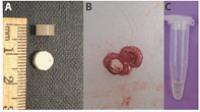 |
Metabolic profiling of the tumor interstitial fluid using NMR:
contribution of breast cancer subtypes and VEGF overexpression 
Santosh K Bharti1, Louis Dore-Savard1,
Aleksander S Popel2, and Zaver M Bhujwalla1
1The Russell H. Morgan Department of Radiology
and Radiological Science, Johns Hopkins University, School
of Medicine, Division of Cancer Imaging Research, Baltimore,
MD, United States, 2Department
of Biomedical Engineering, Johns Hopkins University, School
of Medicine, Systems Biology Laboratory, Baltimore, MD,
United States
Interstitial fluid (IF) is a key component of the tumor
microenvironment (TME) that encompasses the secretome and
holds the key to several of the phenotypic traits of cancer.
Modern analytical methods like 1H MR spectroscopy (MRS)
allow for comprehensive metabolic characterization of
tissue, cell, and bio-fluids content to better understand
the TME and cancer metabolism. Here, for the first time, we
have metabolically characterized TIF from triple negative
and estrogen receptor (ER)-positive human breast tumor
xenografts with or without VEGF overexpression and detected
significant differences between tumor types and with VEGF
overexpression.
|
| |
10:42
 |
0837.
 |
NMR-based fecal metabolomics fingerprinting as predictors of
earlier diagnosis in patients with colorectal cancer 
Yan Lin1, Changchun Ma2, Zhening Wang1,
Zhiwei Shen1, and Renhua Wu1
1Radiology Department, Second Affiliated
Hospital, Shantou University Medical College, Shantou City,
China, People's Republic of, 2Radiation
Oncology, Cancer Hospital, Shantou University Medical
College, Shantou City, China, People's Republic of
Colorectal cancer (CRC) is a growing cause of mortality in
developing countries, warranting investigation into its
earlier detection for optimal disease management.This study
aimed to validate the ability of NMR-based fecal
metabolomics fingerprinting as predictors of earlier
diagnosis in CRC patients.Our findings revealed that the
fecal metabolic profiles of healthy controls can be
distinguished from CRC patients, even in the early stage
(stage I/II), highlighting the potential utility of NMR-based
fecal metabolomics fingerprinting as predictors of earlier
diagnosis in CRC patients.
|
| |
10:54
|
0838.
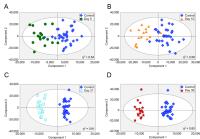 |
NMR metabolomics of biofluids for early diagnosis of brain
metastasis 
James R Larkin1, Alex M Dickens2,
Timothy D W Claridge3, Daniel C Anthony2,
and Nicola R Sibson1
1CRUK and MRC Oxford Institute for Radiation
Oncology, Department of Oncology, University of Oxford,
Oxford, United Kingdom, 2Department
of Pharmacology, University of Oxford, Oxford, United
Kingdom,3Department of Chemistry, University of
Oxford, Oxford, United Kingdom
Secondary tumours, or metastases, in the brain are currently
detected at a late stage by gadolinium-enhanced MRI. We used
mouse models of brain metastases, coupled with high
resolution NMR of urine to identify characteristic patterns
of metabolites in tumour-bearing animals. A model with a
tumour cells implanted directly in the brain showed
sensitive and specific detection at day 5 with increasing
separation at later time points. Models injecting cells into
the heart or venous circulation give rise to differing
systemic and central nervous system (CNS) tumour burdens.
Metabolite patterns allow identification of these animals
with a heavy CNS tumour burden.
|
| |
11:06
|
0839.
 |
Hyperpolarized [1-13C]-Pyruvate Differentiates Distinctive
Molecular Phenotypes in Diffuse Intrinsic Pontine Gliomas 
Ilwoo Park1, Rintaro Hashizume2,
Joanna Phillips3,4, Sabine Mueller3,5,
and Sarah Nelson1,6
1Radiology and Biomedical Imaging, University of
California San Francisco, San Francisco, CA, United States, 2Neurological
Surgery, Northwestern University, Chicago, IL, United
States, 3Neurological
Surgery, University of California San Francisco, San
Francisco, CA, United States, 4Pathology,
University of California San Francisco, San Francisco, CA,
United States, 5Pediatrics,
University of California San Francisco, San Francisco, CA,
United States, 6Bioengineering
and Therapeutic Sciences, University of California San
Francisco, San Francisco, CA, United States
Diffuse intrinsic pontine gliomas (DIPGs) are one of the
most difficult pediatric cancers to treat. This study
investigated the feasibility of 13C
magnetic resonance spectroscopic imaging (MRSI) of
hyperpolarized (HP) [1-13C]pyruvate for
differentiating molecular characteristics of DIPGs.
Differences in the lactate signal that were observed in two
distinct biopsy-originated orthotopic DIPG tumors were
associated with changes in the levels of LHDA and HIF-1α
activity. This suggests that the non-invasive
characterization of DIPGs using this new neuroimaging method
may be helpful for assessing treatment response and tumor
progression.
|
| |
11:18
 |
0840.
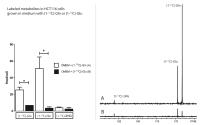 |
Glutamatergic production of 2HG in IDH1-mutant tumor cells is
retained by glutamate import in glutamine-free medium 
Tom Peeters1, Vincent Breukels1,
Krissie Lenting2, Sanne van Lith2,
Arno van Rooij3, Remco Molenaar4,
William Leenders2, and Arend Heerschap1
1Radiology and Nuclear Medicine, Radboud
university medical center, Nijmegen, Netherlands, 2Pathology,
Radboud university medical center, Nijmegen, Netherlands, 3Laboratory
Medicine, Radboud university medical center, Nijmegen,
Netherlands, 4Cell
Biology and Histology, Academic Medical Center, Amsterdam,
Netherlands
This study demonstrates that in IDH1-mutant tumor cells the
pool of oncometabolite 2HG is predominantly replenished by
αKG precursors glutamine and glutamate, and to a lesser
extent by glucose-derived metabolites. Furthermore, we show
that 2HG production is not significantly decreased when
total the pool of glutamine and glutamate drops, which
occurs upon substitution of glutamine by glutamate in the
culture medium.
|
| |
11:30
|
0841.
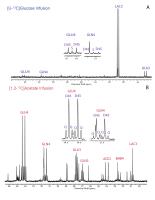 |
Differential Metabolism of Glucose and Acetate in Mitochondria
of Early Stage Breast Cancer In Vivo - Permission Withheld
Elizabeth Maher1, Kumar Pichumani2,
Venetia Sarode3, Tomoyuki Mashimo1,
Manoj Cheriyan1, Vamsidhara Vemireddy1,
Barbara Haley1, Dean Sherry2, Roshni
Rao4, Craig Malloy2, and Robert Bachoo5
1Internal Medicine, UT Southwestern Medical
Center, Dallas, TX, United States, 2Advanced
Imaging Research Center, UT Southwestern Medical Center,
Dallas, TX, United States, 3Pathology,
UT Southwestern Medical Center, Dallas, TX, United States, 4Surgery,
UT Southwestern Medical Center, Dallas, TX, United States, 5Neurology
and Neurotherapeutics, UT Southwestern Medical Center,
Dallas, TX, United States
Metabolic reprogramming of bioenergetic substrate
utilization was shown in primary and metastatic brain
tumors. Whether the use of substrates other than glucose to
fuel the citric acid cycle is a property of cancer cell
growth in the brain or a fundamental property of a
transformed cell is not known. To address this question we
studied early stage breast cancer patients using infusion of 13C-glucose
or 13C-acetate
during initial surgery. 13C-NMR spectra of
resected tumors show that acetate but not glucose is
oxidized in the citric acid cycle, suggesting that acetate
may contribute to energy production in these early stage
cancers.
|
| |
11:42
|
0842.
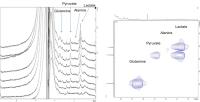 |
Simultaneous imaging and 1H spectroscopy of small volume (1 µl)
intracerebral microdialysate in healthy and glioblastoma-bearing
rats using highly sensitive micro-coils 
Silvia Rizzitelli1, Stefan Glöggler1,
Noël Pinaud1, Gerard Raffard1,
Veronique Bouchaud1, Vanessa Zhendre1,
Stephane Sanchez1, Alan Wong2, and
Yannick Cremillieux1
1Centre de Resonance Magnétique des Systemes
Biologiques, University of Bordeaux, Bordeaux, France, 2NIMBE/LSDRM,
CEA-Saclay, Gif-sur-Yvette, France
The challenge of this study was to investigate the ability
of a custom-made 1H microsolenoidal coil operating at 7T,
with an inner volume of 1 μL, of visualizing the on-line
metabolism of brain metabolites through the use of a
microdialysis catheter, carried out with the complementarity
of MRI and MRS techniques. 1H-MR
spectra of in
vitro (human
gliobastoma cells) and in
vivo (healthy
and glioblastoma-bearing rats) were acquired every 3.50
minutes to monitor the real-time variations of metabolites
concentration, after injection of 13C
labelled compunds.
|
| |
11:54
|
0843.
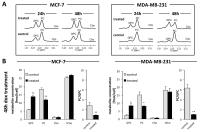 |
Molecular Effects of the Chemotherapeutic Drug Doxorubicin on
Choline Phospholipid Metabolism of Breast Cancer Cells 
Menglin Cheng1, Asif Rizwan1, Zaver M.
Bhujwalla1,2, Lu Jiang1, and Kristine
Glunde1,2
1The Russell H. Morgan Department of Radiology
and Radiological Science, The Johns Hopkins University
School of Medicine, Baltimore, MD, United States, 2The
Sidney Kimmel Comprehensive Cancer Center, The Johns Hopkins
University School of Medicine, Baltimore, MD, United States
This study shows that the widely used chemotherapeutic drug
doxorubicin increases the 1H
or 31P
MRS detectable glycerophosphocholine (GPC) concentration,
while decreasing the phosphocholine (PC) concentration in
human MCF-7 and MDA-MB-231 breast cancer cell lines. This
GPC increase and PC decrease was caused by
doxorubicin-induced decreases in the expression of the
GPC-phosphodiesterase GDPD6, choline kinase α, and
phospholipase D1. GDPD6 silencing was able to counteract the
doxorubicin-induced promotion of breast cancer cell
migration, which can occur at low doxorubicin
concentrations. GPC, PC, and PC/GPC may serve as
non-invasive surrogate makers of therapeutic response in
breast cancer patients undergoing doxorubicin chemotherapy.
|
| |
12:06
|
0844.
 |
Measurement of Liver Fat Fraction and T2 Relaxation Times in an
Experimental Rat Model of Hepatocarcinogenesis at 9.4T 
Sami Alghamdi1,2, Gary Cowin1, Ian
Brereton1, and Yasvir Tesiram1
1Centre for Advanced Imaging, University of
Queensland, Brisbane, Australia, 2Dept.
of Radiological sciences,King Saud University, Riyadh, Saudi
Arabia
To investigate the correlation between fat fraction (FF)
measured by in/out-phase (IP/OP) imaging, with transverse
relaxation time (mono- and bi-exponential T2 values) and
their relationship with nodular and tumour formation in the
liver of rats maintained on a choline and amino acid
modified diet (CDAA diet).
|
| |
12:18
|
0845.
 |
Evaluation of nearby lymph nodes in a tumor mouse model by
longitudinal MRI imaging at 11.7 Tesla. 
María Jiménez-González1, Sandra Plaza-García1,
Géraldine Pastor1, and Torsten Reese1
1Molecular Imaging Unit, CIC biomaGUNE, San
Sebastián, Spain
We developed a pancreatic tumor xenograft model in a nude
mice to study characteristics of nearby lymph nodes. Using
non invasive in
vivo MR
imaging at 11.7 Tesla, we monitored the tumor progression
from 8 to 20 weeks. We observed enlarged lymph nodes in
tumor bearing animals comparing to controls. Histological
analysis demonstrated the presence of significant
histiocytosis but not metastasis. Our study suggests that
lymph node histiocytosis, in absence of functional
adaptative immune system, plays a significant role of the
innate immuno defense against cancer cells spreading.
|
|










